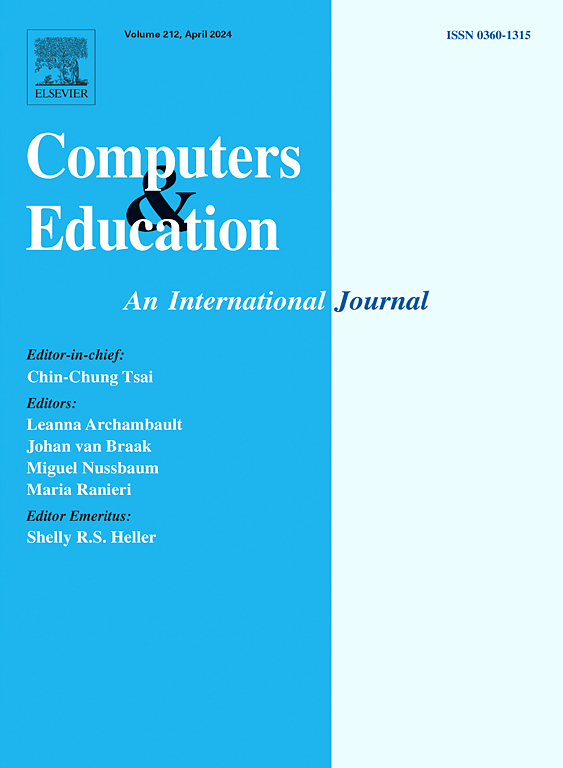Internet usage inequality among high school students: Patterns, motivational predictors, and educational outcomes
IF 10.5
1区 教育学
Q1 COMPUTER SCIENCE, INTERDISCIPLINARY APPLICATIONS
引用次数: 0
Abstract
Concerns over Internet usage inequality, particularly excessive usage patterns among adolescents, have intensified due to their potential to widen educational disparities and reinforce existing social inequalities. Many countries have implemented school-wide mobile phone bans to curb inappropriate use during school hours. However, little is known about how such policies influence students' Internet use in out-of-school contexts, or how different cultural and motivational factors help shape these usage patterns. This cross-sectional study examined heterogeneous Internet use patterns within and outside school across school types, under a national mobile phone ban policy, using data from 5160 Chinese high school students (51 % girls, Mage = 15.64, SD = 0.57). Latent profile analyses revealed three usage profiles in elite schools (minimal users, moderate users, and all-time heavy users) and four profiles in non-elite schools, including a distinct group termed “after-school heavy users”. Multinomial logistic regression showed that in non-elite schools, high ICT-related interest and perceived autonomy in ICT use were associated with higher odds of belonging to the all-time heavy users and after-school heavy users, while perceived ICT competence and ICT as a topic in social interaction predicted more balanced profiles. Notably, after-school heavy users exhibited significantly lower academic performance and ICT competencies, identifying them as a potential risk group in the context of digital inequality. These findings extend our understanding of digital inequality by highlighting the importance of usage patterns beyond mere usage time, and offer practical insights for refining ICT policies and interventions aimed at promoting responsible and equitable Internet use.
高中生网络使用不平等:模式、动机预测因素和教育成果
由于互联网有可能扩大教育差距和加剧现有的社会不平等,因此对互联网使用不平等,特别是青少年过度使用模式的关注已经加剧。许多国家已经在全校范围内实施了手机禁令,以遏制在上课时间不当使用手机。然而,对于这些政策如何影响学生在校外环境下的互联网使用,或者不同的文化和动机因素如何帮助塑造这些使用模式,人们知之甚少。本横断面研究在全国禁止使用手机政策的情况下,利用5160名中国高中生(51%为女生,Mage = 15.64, SD = 0.57)的数据,考察了不同学校类型的校内外互联网使用模式的异质性。潜在特征分析揭示了精英学校的三种使用特征(最少使用者、中等使用者和长期重度使用者)和非精英学校的四种使用特征,包括一个被称为“课后重度使用者”的独特群体。多项逻辑回归显示,在非精英学校中,信息通信技术相关兴趣和信息通信技术使用自主性高与属于全天重度用户和课后重度用户的可能性相关,而信息通信技术能力和信息通信技术作为社交互动主题的感知预测更为平衡。值得注意的是,课后重度使用者的学习成绩和ICT能力明显较低,这表明他们是数字不平等背景下的潜在风险群体。这些发现通过强调使用模式不仅仅是使用时间的重要性,扩展了我们对数字不平等的理解,并为完善旨在促进负责任和公平的互联网使用的ICT政策和干预措施提供了实际见解。
本文章由计算机程序翻译,如有差异,请以英文原文为准。
求助全文
约1分钟内获得全文
求助全文
来源期刊

Computers & Education
工程技术-计算机:跨学科应用
CiteScore
27.10
自引率
5.80%
发文量
204
审稿时长
42 days
期刊介绍:
Computers & Education seeks to advance understanding of how digital technology can improve education by publishing high-quality research that expands both theory and practice. The journal welcomes research papers exploring the pedagogical applications of digital technology, with a focus broad enough to appeal to the wider education community.
 求助内容:
求助内容: 应助结果提醒方式:
应助结果提醒方式:


